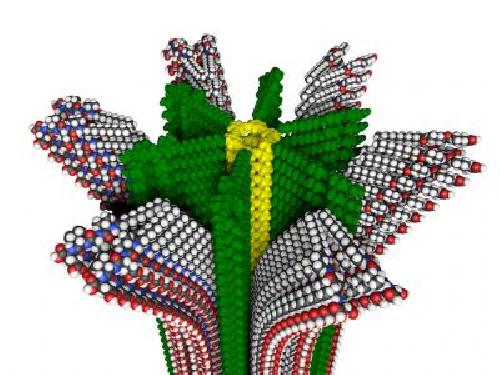Imagine a polymer with removable parts that can deliver something to the environment and then be chemically regenerated to function again. Or a polymer that can lift weights, contracting and expanding the way muscles do.
These functions require polymers with both rigid and soft nano-sized compartments with extremely different properties that are organized in specific ways. A completely new hybrid polymer of this type has been developed by Northwestern University researchers that might one day be used in artificial muscles or other life-like materials; for delivery of drugs, biomolecules or other chemicals; in materials with self-repair capability; and for replaceable energy sources.
"We have created a surprising new polymer with nano-sized compartments that can be removed and chemically regenerated multiple times," said materials scientist Samuel I. Stupp, the senior author of the study.
 Northwestern University researchers have developed a new hybrid polymer with removable supramolecular compartments, shown in this molecular model. Credit: Mark E. Seniw, Northwestern University
Northwestern University researchers have developed a new hybrid polymer with removable supramolecular compartments, shown in this molecular model. Credit: Mark E. Seniw, Northwestern University
"Some of the nanoscale compartments contain rigid conventional polymers, but others contain the so-called supramolecular polymers, which can respond rapidly to stimuli, be delivered to the environment and then be easily regenerated again in the same locations. The supramolecular soft compartments could be animated to generate polymers with the functions we see in living things," he said.
Stupp is director of Northwestern's Simpson Querrey Institute for BioNanotechnology. He is a leader in the fields of nanoscience and supramolecular self-assembly, the strategy used by biology to create highly functional ordered structures.
The hybrid polymer cleverly combines the two types of known polymers: those formed with strong covalent bonds and those formed with weak non-covalent bonds, well known as "supramolecular polymers." The integrated polymer offers two distinct "compartments" with which chemists and materials scientists can work to provide useful features.
The study will be published in the Jan. 29 issue of Science.
"Our discovery could transform the world of polymers and start a third chapter in their history: that of the 'hybrid polymer,'" Stupp said. "This would follow the first chapter of broadly useful covalent polymers, then the more recent emerging class of supramolecular polymers.
"We can create active or responsive materials not known previously by taking advantage of the compartments with weak non-covalent bonds, which should be highly dynamic like living things. Some forms of these polymers now under development in my laboratory behave like artificial muscles," he said.
Polymers get their power and features from their structure at the nanoscale. The covalent rigid skeleton of Stupp's first hybrid polymer has a cross-section shaped like a ninja star -- a hard core with arms spiraling out. In between the arms is the softer "life force" material. This is the area that can be animated, refreshed and recharged, features that could be useful in a range of valuable applications.
"The fascinating chemistry of the hybrid polymers is that growing the two types of polymers simultaneously generates a structure that is completely different from the two grown alone," Stupp said. "I can envision this new material being a super-smart patch for drug delivery, where you load the patch with different medications, and then reload it in the exact same compartments when the medicine is gone."
Stupp also is the Board of Trustees Professor of Materials Science and Engineering, Chemistry, Medicine and Biomedical Engineering and holds appointments in Northwestern University Feinberg School of Medicine, the McCormick School of Engineering and Applied Science and the Weinberg College of Arts and Sciences.
Stupp and his research team also discovered that the covalent polymerization that forms the rigid compartment is "catalyzed" by the supramolecular polymerization, thus yielding much higher molecular weight polymers.
The strongly bonded covalent compartment provides the skeleton, and the weakly bonded supramolecular compartment can wear away or be used up, depending on its function, and then be regenerated by adding small molecules. After the simultaneous polymerizations of covalent and non-covalent bonds, the two compartments end up bonded to each other, yielding a very long, perfectly shaped cylindrical filament.
To better understand the hybrid's underlying chemistry, Stupp and his team worked with George C. Schatz, a world-renowned theoretician and a Charles E. and Emma H. Morrison Professor of Chemistry at Northwestern. Schatz's computer simulations showed the two types of compartments are nicely integrated with hydrogen bonds, which are bonds that can be broken. Schatz is a co-author of the study.
"This is a remarkable achievement in making polymers in a totally new way -- simultaneously controlling both their chemistry and how their molecules come together," said Andy Lovinger, a materials science program director at the National Science Foundation, which funded this research.
"We're just at the very start of this process, but further down the road it could potentially lead to materials with unique properties -- such as disassembling and reassembling themselves -- which could have a broad range of applications," Lovinger said.
The paper is titled "Simultaneous covalent and noncovalent hybrid polymerizations."
In addition to Stupp and Schatz, other authors of the paper are Zhilin Yu (first author), Faifan Tantakitti, Tao Yu and Liam C. Palmer, all from Northwestern.
source: Northwestern University